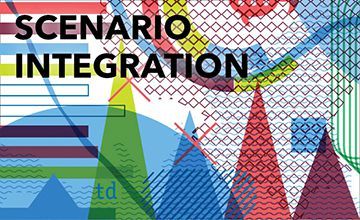Scenario integration
Using scenario planning, this tool allows for collectively drafting possible future developments of a societal challenge.
Stauffacher M 2020. Scenario integration. td-net toolbox profile (3). Swiss Academies of Arts and Sciences: td-net toolbox for co-producing knowledge. www.transdisciplinarity.ch/toolbox. doi.org/10.5281/zenodo.3717308
What is the scenario integration workshop? | The scenario integration tool uses qualitative and quantitative elements of scenario planning to collectively draft possible developments of a societal challenge. It is typically applied in a structured one-day workshop. The tool is suited for use by heterogeneous groups of experts with diverse disciplinary backgrounds as well as various societal actors. |
| Why should it be applied? | In future or transition-oriented research projects, questions about possible developments abound. To accommodate qualitative and quantitative thought-styles for generating such future outlooks, a platform and language for exchange and interaction are necessary. |
| When should it be applied? | The tool fits best when future is explored, that means when possible futures (target knowledge) are described and selected. It is necessary that researchers have already acquired a good understanding of the system (systems knowledge) and have identified system variables. |
| How does it work? | We suggest to organize the tool as group workshop of one day along the following steps:
5) In the plenary: the two groups mutually present their results and answer questions of clarification. 6) Continuation in the two groups:
7) In the plenary: the two groups mutually present their results, answer questions of clarification and discuss the following points:
Follow-up: It is recommended to clarify how the scenarios are going to be used by the different researchers or subprojects. The developed scenarios can later be assessed by various methods and likewise strengths and weaknesses of different futures can be explored, all guiding the elaboration of adequate strategic actions. |
| How are thought styles bridged? | The scenario integration tool bridges qualitative visioning with quantitative modelling approaches. It offers both a platform (typically a full day of joint work) and a language (e.g. impact variables, values, consistency) which allow thought collectives to communicate and exchange knowledge with each other. |
| What’s the output/outcome? | At the end of the workshop a reasonably complete draft of a set of different scenarios should be available. All scenarios should be on the same level of abstraction and describe various possible future developments of a societal challenge using the same set of variables to which different values are assigned. Further, it should be clear who finalises these scenarios after the workshop. An agreement that all researchers (or subprojects) are using the developed scenarios in their subsequent research steps may be helpful. At the process level, an improved mutual understanding between the project team members will be achieved. |
| Who participates in what role? | All researchers involved or at least one researcher representing each subproject, respectively, plus relevant societal actors should participate. Care should be taken when inviting societal actors: they should be familiar or willing to work with the abstract language of “impact variables” and “values of impact variables”. Alternatively, the views of societal actors can be collected separately in form of narratives, storylines or visions. One or two facilitators are necessary to introduce scenario planning, moderate plenary sessions and assist in the working group sessions. |
| What do I need to prepare? | Invite all research team members or representatives (preparatory homework for all: individually collect possible impact variables), secure enough time (full day), organise a suitable room (big enough to allow work in subgroups in the same room), prepare material for group facilitation (cards, white board, flipcharts, enough pens, etc.). |
| When not to use the method? | The tool is useful in future oriented, prospective studies. It should not be used when disagreement about the aim and scope of building scenarios exist. |


